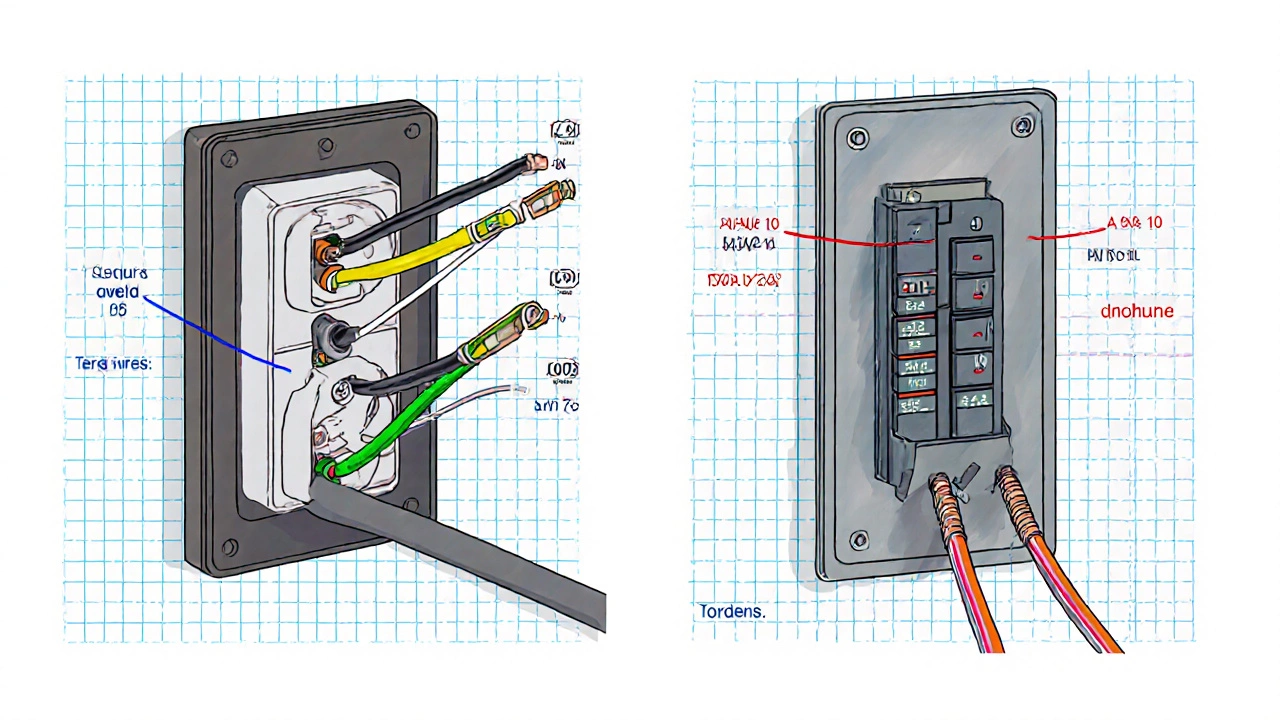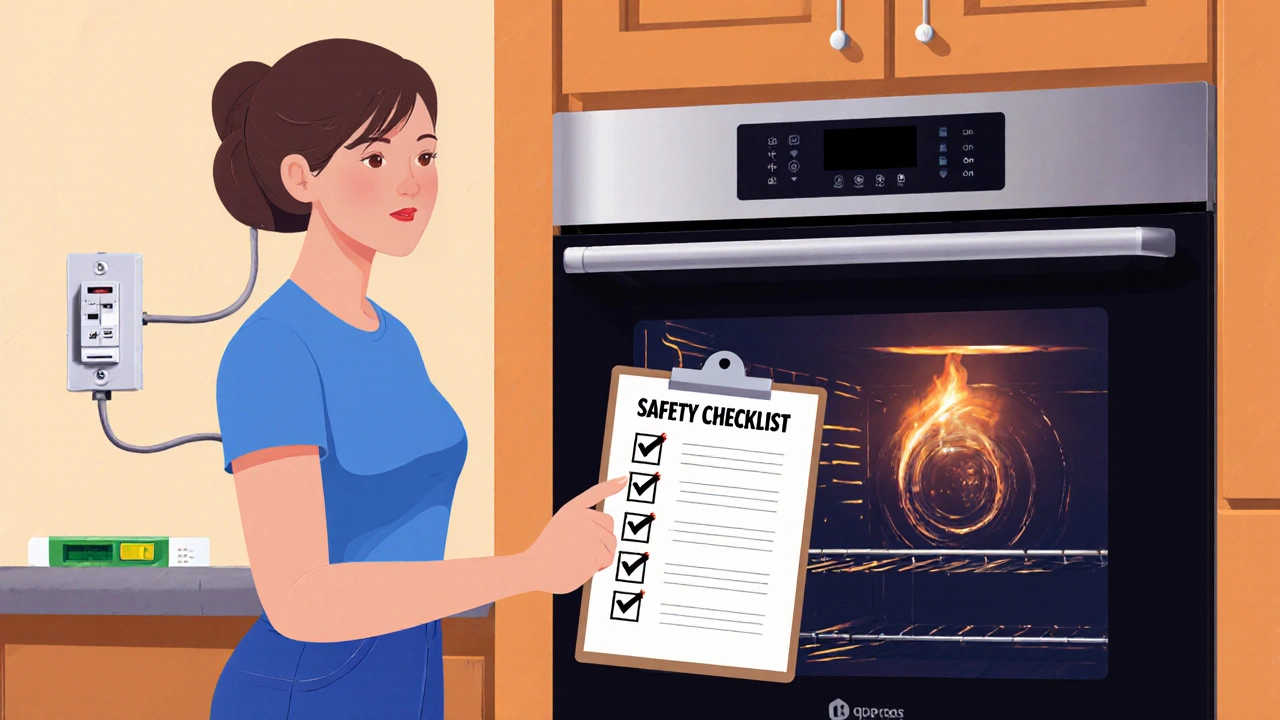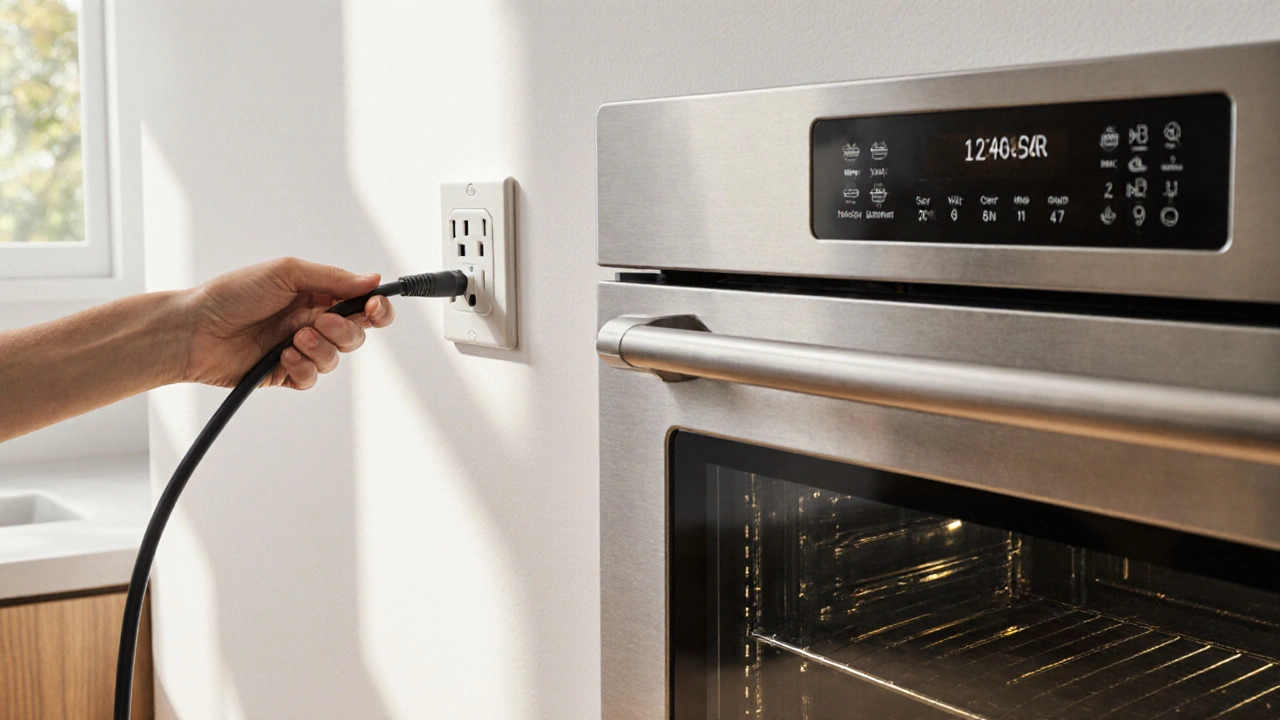Oven Circuit Compatibility Checker
Oven Installation Requirements
Most electric ovens require:
- 240V dedicated circuit
- 30A breaker (125% of oven rating)
- AWG 10 (10mm²) copper wire
- NEMA 14-30R outlet for plug-in models
Enter Your Oven Specifications
Check Your Existing Circuit
When you bring home a brand‑new electric oven, the first thing you probably wonder is: can I just plug it in and start cooking? The short answer is yes-if the right conditions are met. But digging deeper reveals a handful of electrical specs, safety rules, and preparation steps you need to know before you pull that plug.
Below is a practical, no‑nonsense guide that walks you through the power requirements, the difference between plug‑in and hard‑wired models, and a step‑by‑step checklist to ensure a safe, code‑compliant install. If you follow these steps, you’ll avoid costly mistakes, keep the lights on, and get your oven up and running without calling an electrician-unless the job truly calls for one.
Quick Takeaways
- Most modern electric ovens need a dedicated 240V circuit with a 30A breaker.
- Plug‑in ovens use a heavy‑duty 10‑amp, 220‑240V outlet (usually a NEMA 14‑30 or 14‑50).
- Hardwired ovens eliminate the plug but still require the same circuit size and wiring gauge.
- Never exceed the oven’s rated amperage; undersized wiring is a fire hazard.
- Always turn off the breaker, verify no voltage, and double‑check grounding before connecting.
Understanding Power Requirements
Electric oven is a high‑power kitchen appliance that typically draws between 12A and 30A at 240V. In NewZealand, the standard supply is 230‑V (±10%). The appliance’s nameplate lists the exact voltage and maximum current; that information drives the rest of the installation.
Why does a dedicated circuit matter? A dedicated circuit means no other devices share the same breaker. Sharing can cause nuisance trips because the oven’s heating elements surge when you preheat, pulling a lot of current in a short burst.
Key numbers to note on the oven’s label:
- Rated voltage (e.g., 230V or 240V)
- Maximum current (e.g., 20A)
- Power rating in watts (Voltage × Current, e.g., 4,800W)
These values dictate the breaker size (usually 125% of the oven’s current) and the wiring gauge (AWG 10 for up to 30A in NZ). Circuit breaker is a protective device that trips when current exceeds its rating, preventing wires from overheating.
Plug‑in vs Hardwired Ovens
Many manufacturers market “plug‑in” electric ovens to simplify the install. The plug is simply a heavy‑duty connector that mates with a matching wall outlet. Hardwired ovens have a fixed wiring harness that you connect directly to the circuit’s terminals.
Both approaches require the same circuit capacity; the difference lies in the physical connection.
| Aspect | Plug‑in Oven | Hardwired Oven |
|---|---|---|
| Connection type | Heavy‑duty 3‑ or 4‑pin plug (NEMA 14‑30/14‑50) | Directly wired to breaker terminals |
| Installation ease | Simple plug‑in, no soldering | Requires stripping wires and tightening terminal screws |
| Typical breaker size | 30A (or per oven spec) | 30A (or per oven spec) |
| Wire gauge | AWG 10 (10mm²) copper | AWG 10 (10mm²) copper |
| Mobility | Can be unplugged for relocation | Fixed; moving requires rewiring |
| Common issues | Loose plug, outlet wear | Improper terminal torque, exposed conductors |
In practice, the plug‑in option saves a few minutes, but both still demand a properly sized circuit and correct wiring.

Safety First: What the Wiring Must Meet
The Dedicated circuit is a single circuit that supplies only the oven. In NewZealand, the wiring must comply with AS/NZS 3000:2022 (the Wiring Rules). Key safety checkpoints:
- Breaker rating: Choose a breaker at least 125% of the oven’s maximum current. For a 20A oven, a 25A breaker is acceptable, but 30A is the common size.
- Wire gauge: Use Wiring gauge AWG 10 (10mm²) copper for up to 30A. Larger ovens may need 8mm².
- Grounding: The outlet or hardwired connection must have a solid earth connection. A missing ground can cause electric shock.
- Outlet type: For plug‑in ovens, install a NEMA 14‑30R or 14‑50R outlet with a three‑wire (L1, L2, N) plus ground configuration.
- Temperature rating: All components (outlet, conduit, connectors) should be rated for at least 90°C.
If any of these criteria feel beyond your comfort zone, it’s wise to hire a licensed Electrical contractor. Mistakes in electrical work are a leading cause of home fires.
Step‑by‑Step Replacement Guide
- Verify the circuit: Turn off the main breaker for the kitchen. Use a non‑contact voltage tester on the outlet or wiring to confirm there’s no voltage.
- Check the outlet: If you have a plug‑in oven, confirm the wall outlet matches the oven’s plug (usually a 14‑30R). Look for signs of wear, overheating, or loose screws.
- Measure the wire size: Expose a short section of the cable (behind the outlet or at the breaker) and check the printed AWG. It should be 10mm² for a 30A circuit.
- Inspect the breaker: The breaker should be labeled for the oven’s circuit and rated at 30A. If the label is missing, replace it with a correctly sized breaker.
- Prepare the oven: Remove the old oven (if swapping). Pull the power cord out, clean the cavity, and set the new oven near its final spot.
- Connect the plug: For a plug‑in model, align the oven’s plug with the outlet, ensuring the pins lock securely. Give the cord a gentle tug-no movement should be felt.
- Hardwire the oven: If the new oven is hardwired, strip the cable ends, connect L1 to the breaker’s “A” terminal, L2 to “B”, and the earth wire to the ground bar. Tighten screws to the manufacturer’s torque spec (usually 2.5Nm).
- Secure the oven: Slide the oven into its cavity, level it with a spirit level, and anchor it according to the manual (often with brackets underneath).
- Restore power: Turn the breaker back on. Verify the oven’s display lights up. Run a quick “heat‑up” test (200°C for 10min) to confirm the heating elements work.
- Final safety check: Ensure the cord or wiring is not pinched, that there’s clearance from the back wall, and that the oven’s door seals properly.
That’s it-your oven is ready to bake, roast, and broil. If any step feels uncertain, pause and call an Electrical contractor.

Common Mistakes to Avoid
- Using a 15A circuit: An oven that draws 20A will constantly trip a 15A breaker.
- Undersized wire: A 12mm² (AWG 8) wire is fine, but a 14mm² (AWG 12) is not for 30A loads.
- Skipping grounding: Some older homes have two‑wire outlets. Adding a ground or using a GFCI does not replace a proper earth connection.
- Forgetting to level: An unlevel oven can cause uneven heating and stress the door hinges.
- Leaving the old cord in place: Old cords can become brittle. Always replace with the factory‑supplied cord.
Checklist Before You Plug In
- Dedicated 30A breaker installed and labeled?
- Correct outlet type (NEMA 14‑30R/14‑50R) present and in good condition?
- Wiring gauge matches or exceeds the oven’s amperage requirement?
- Ground wire securely connected?
- Oven’s power rating matches the circuit’s voltage (230V vs 240V)?
- All connections are tight, with no exposed copper?
- Clearance behind oven meets manufacturer’s minimum (usually 5cm)?
- Breaker turned on and voltage confirmed at the outlet?
Frequently Asked Questions
Do I need a licensed electrician to install a plug‑in electric oven?
If the existing circuit already meets the oven’s voltage, amperage, and grounding requirements, you can safely plug the oven in yourself. However, any work that involves replacing the breaker, adding a new dedicated circuit, or upgrading wiring must be done by a licensed electrician under NewZealand’s AS/NZS 3000 rules.
Can I use a regular 10A household outlet for my electric oven?
No. Standard household outlets are usually rated for 10‑15A at 230V, far below the 20‑30A that most ovens need. Using a low‑rated outlet will cause frequent breaker trips and creates a fire hazard.
What’s the difference between a 14‑30R and a 14‑50R outlet?
Both are four‑prong 240V outlets with a ground. The 14‑30R is rated for up to 30A, while the 14‑50R handles up to 50A. Choose the one that matches your oven’s breaker size-most residential ovens use a 30A breaker, so a 14‑30R is sufficient.
How can I tell if my existing wiring is too small?
Locate the cable near the breaker or outlet and read the printed size (e.g., 2.5mm², 4mm²). If it’s smaller than the required 10mm² for a 30A circuit, you need to have it upgraded. A licensed electrician can replace the cable without disturbing the rest of the house.
Is it safe to use an extension cord with an electric oven?
Never. Extension cords are not rated for the high current draw of ovens and can overheat. Always plug directly into a proper dedicated outlet.
By following this guide, you’ll know exactly when a simple plug‑in will do the trick and when it’s time to call in a professional. Armed with the right circuit, the right wire, and a solid safety checklist, your new electric oven can become the centerpiece of your kitchen without a hitch.

I am an expert in the services industry with a focus on appliance repair. My passion lies in understanding how things work and educating others in simple, engaging ways. This enthusiasm fuels my writing, where I delve into topics around appliance maintenance and troubleshooting. I aim to make these subjects clear and accessible to all readers.